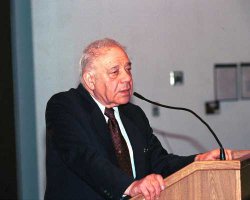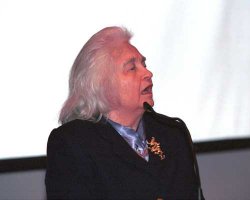 | |
| The Newsletter of the World Innovation Foundation May - August 2003 Vol. 7 Edition 2a (Supplement) | |
| Drs Jerome and Isabella Karle | ||||||
 Jerome Karle was born in Brooklyn, New York, on June 18, 1918. He attended New York City schools and graduated from the City College of New York in 1937, the first recipient of the Caduceus Award for excellence in the Natural Sciences. He obtained an M.A. degree in Biology in 1938 at Harvard University. After working at the New York State Health Department, he attended the University of Michigan and received M.S. and Ph.D. degrees in Physical Chemistry in 1942 and 1944, respectively. Dr. Karle joined the Naval Research Laboratory in 1944 and since 1968, he has been the Chief Scientist of the Laboratory for the Structure of Matter (LSM) Jerome Karle's research has been concerned with diffraction theory and its application to the determination of atomic arrangements in various states of aggregation, gases, liquids, amorphous solids, fibers, and macromolecules. This research has resulted in new techniques for structure determination and a broad variety of applications. His work in crystal structure analysis was recognized by the 1985 Nobel Prize in Chemistry. Karle is the President of the World Innovation Foundation. Karle is a Fellow of the American Physical Society, a member of the National Academy of Sciences and the American Philosophical Society, has served as president of the International Union of Crystallography, and is a member of a number of other professional societies. He has been chairman of the Chemistry Section of the National Academy of Sciences. Some time ago, he was a Professorial Lecturer in the University College of the University of Maryland and a Visiting Professor at the University of Kiel in Germany. He has also lectured at many international schools and symposia and has served on a number of international scientific organizations. Karle's recent research interests have concerned analytical techniques for the determination of macromolecular structure. Some recent applications have involved the use of major technical advances such as high intensity synchrotron sources. In one such application, Prof. Janet Smith of Purdue University, a former postdoctoral member of NRL in LSM, and colleagues, have solved a structure containing about 15,000 nonhydrogen atoms. A most recent interest is in a developing field that he and his research colleagues call quantum crystallography. It concerns a method for combining X-ray diffraction data for crystals with quantum mechanics in order to obtain wave functions that are consistent with the X-ray data. The objective is to extend the use of X-ray diffraction beyond the determination of atomic arrangements, which it does quite well, to the determination of additional features such as charges on atoms and energies. Laboratory for the Structure of Matter, Naval Research Laboratory, Washington, D.C., USA. Ph.D. and M.S.(Physical chemistry) University of Michigan. A Fellow of American Physical Society, a member of the National Academy of Sciences and the American Philosophical Society, and a member of a number of other professional societies. Awards: Nobel Prize in Chemistry, 1985, shared with Dr. Herbert A. Hauptman. Dr. Karle accepted the Presidency of the World Innovation Foundation in 1999 after the sad passing of the WIF’s Founding President Nobel Laureate Dr. Glenn Seaborg (Element 106 Seaborgium). Although a very sad happening, Dr. Karle was Glenn Seaborg’s chosen successor and where they had both previously worked together on the ‘Manhattan Project’, the greatest concentrated scientific effort that humankind has ever seen. Dr. Jerome Karle was born in Brooklyn, New York, on June 18, 1918. He was born into a family in which there were generations of artistic people, several of whom had careers in the fine and commercial arts. A career in science was a most remote profession. Nevertheless, at an early age, perhaps eight or nine, he was avidly reading popular accounts of science, for example those of Sir James Jeans, and from that time on, he expected to spend his life in scientific pursuits. At Michigan, Dr. Karle and his wife, Isabella, were among the first graduate students of Lawrence O. Brockway, Brockway was among the first graduate students of Linus Pauling. Both Dr. Karle and his wife did their thesis work on the molecular structure of gaseous molecules. Dr. Karle has served as president of the International Union of Crystallography, He has been chairman of the Chemistry Section of the National Academy of Sciences. Some time ago, he was a Professorial Lecturer in the University College of the University of Maryland and a Visiting Professor at the University of Kief in Germany. He has also lectured at many international schools and symposia and has served on a number of international scientific organizations. Dr. Karle's research has been concerned with diffraction theory and its application to the determination of atomic arrangements of substances in various states of aggregation, gaseous, liquid, amorphous solid, fibrous and crystalline. This research has resulted in new techniques for structure determination and a broad variety of applications. Dr. Isabella Karle has been the pioneer in bridging the gap between the theoretical formula for crystal structure determination and the experimental methodology required to achieve useful applications. She has also collaborated in major advances in the structure determination of molecules in the vapor state. 'I am very apprehensive about the future of human society. Much can be said about this subject, but in general terms, I am appalled by the large fraction of the population that behaves in a selfish, anti-social and often criminal way, the ease with which many individuals can be induced to commit violence and inhumane acts, the needs for instant gratification without consideration of the consequences and the general use of reason to rationalize improper behavior rather than prevent it. Nevertheless, despite daunting barriers, I feel that it is worth a considerable effort to try to improve the world of the future. The world still offers people special joys. Among them I very much enjoyed raising three children and I currently enjoy three-dimensional (stereo-) photography, art, music, swimming which I do daily in a pool at my laboratory, occasional ice skating, and when I am sure that no one else is listening, I play piano.' Some Types of Calculations in Theoretical Chemistry Monday 12 February, 2001 CENTER FOR COMPUTATIONAL SCIENCE AND ENGINEERING USNA  Isabella Karle (nee Lugoski) was born in Detroit, Michigan. She is the daughter of Zygmunt and Elizabeth Lugoski who had emigrated from Poland. After attending the public schools in Detroit, she was awarded a scholarship to the University of Michigan where she earned the B.S. Chem, M.S. and Ph.D. degrees with a speciality in physical chemistry. After serving as a chemist on the development of the atomic bomb project at the University of Chicago (1944), she was an Instructor in Chemistry at the University of Michigan. After World War II, she joined the Naval Research Laboratory in Washington where she still maintains an active research program as a member of the Laboratory for the Structure of Matter. Dr. Isabella Karle's early research concerned the structure analysis of molecules in the vapor state by electron diffraction. She was instrumental in the development of a quantitative procedure by which vibrational motion as well as bond lengths and bond angles in molecules can be determined accurately. In the fifties, her research was directed toward crystal structure analysis. She developed practical procedures based on the theoretical work developed in the Laboratory for the Structure of Matter at NRL for the determination of phases directly from the measured intensities of x-ray reflections. These practical procedures have become adopted world-wide and have been essential to the explosive output of crystal structure determinations that are indispensable to the solution of problems in a number of scientific disciplines: chemistry, biochemistry, biophysics, mineralogy, material science, pharmaceuticals, drug design and medicinal chemistry, for example. There are now in excess of 10,000 published analyses per year, as compared to about 150 per year in the early 1960s. Isabella Karle personally has applied the direct method of phase determination to the early elucidation of molecular formulae and determination of conformations of steroids, alkaloids, frog toxins, photorearrangement products caused by radiation, nanotubes and particularly peptides. This type of structural information has provided the basis for computational chemistry, conformational analyses and the prediction of folding for new substances. She has published more than 330 papers. The work of Dr. Karle has been recognized by a number of awards and honors. Among them have been election to the National Academy of Sciences, the American Academy of Arts and Sciences, and the American Philosophical Society. She has received the Garvan Award of the American Chemical Society, the Hillebrand Award, the WISE Lifetime Achievement Award, the Gregori Aminoff Prize from the Royal Swedish Academy of Sciences, the Bijvoet Medal from the Netherlands, Robert Dexter Conrad Award (ONR), and seven honorary doctorate degrees, among them one from the University of Athens (Greece). Her first award, however, was presented by the Society of Women Engineers. She has served as President of the American Crystallographic Association, on several editorial boards of journals and a number of national committees concerned with various aspects of chemistry and crystallography. In 1993, Dr. Karle was awarded the prestigious Bower Award and Prize for Achievement in Science (Franklin Institute), and in 1995 she received the National Academy of Sciences Award in Chemical Sciences and the National Medal of Science from President Clinton. Other recognitions include her biography in "Women in Chemistry and Physics" and in "The Door and the Dream," a symposium in her honor at an American Chemical Society meeting, and honors at the New York Academy of Sciences. Practical Application of Mathematics to Crystal Structure Determination Monday 12 February, 2001 CENTER FOR COMPUTATIONAL SCIENCE AND ENGINEERING USNA | ||||||
| Extracts from the Website of the WFEO on the 'World Congress on the Digital Divide' | ||||||
| Congress presentation The World Federation of Engineering Organizations’ Committee on Information and Communication, based in Tunis, is to play host next October to an outstanding international event. The highest peak of this week-long (12-19 October 2003) world gathering will be the holding of the three-day (14-16 October 2003) “World Congress on the Digital Divide” (WCDD) aims at making known the engineering and scientific communities’ opinions and solutions to this crucial issue of the Digital Gap separating the developed and developing countries. The WCDD has been recognized as one of the preparatory encounters for the two-stage (Geneva 2003 and Tunis 2005) World Summit on the Information Society (WSIS). The Congress’s main targets being to elaborate the engineers’ and scientists’ viewpoints on the DD and draw up an action plan which will represent these professionals’ contribution to the WSIS. Several high profile speakers have already confirmed their participation in this event. Some 2000 engineers, scientists, lecturers and senior officials from around the globe are expected to take part in the Congress works. This encounter will be taking place simultaneously with the WFEO’s General Assembly. The program of the week encompasses : The General Assembly of the Federation of Francophone Engineering Organizations (FOEF) The Executive Council of the Federation of Arab Engineers (FAE) | ||||||
| www.thewif.org.uk - The World Innovation Foundation - April - July 2001 | S1 | |||||